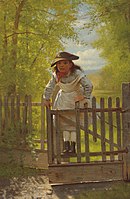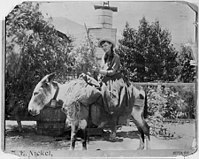| Revision as of 16:28, 27 February 2014 editFlyer22 Frozen (talk | contribs)365,630 edits →See also: Was merged; now simply called Childhood variance.← Previous edit | Revision as of 16:29, 27 February 2014 edit undoFlyer22 Frozen (talk | contribs)365,630 edits →See also: I meant Gender variance.Next edit → | ||
| Line 18: | Line 18: | ||
| ==See also== | ==See also== | ||
| * ] | * ] | ||
| * ] | * ] | ||
| * ] | * ] | ||
Revision as of 16:29, 27 February 2014
This article is about the type of girl. For other uses, see Tomboy (disambiguation).A tomboy is a girl who exhibits characteristics or behaviors considered typical of a boy, including wearing masculine clothing and engaging in games and activities that are physical in nature and are considered in many cultures to be the domain of boys. Tomboy, since its print inception in 1592, according to the Oxford English Dictionary, "has been connected with connotations of rudeness and impropriety".
History and society
Gender scholar Judith Halberstam states that while the defying of gender roles is often tolerated in young girls, adolescent girls who display masculine traits are often repressed or punished. However, the ubiquity of traditionally female clothing, such as dresses, blouses and skirts, has declined among the Western world where it is generally no longer considered a male trait if such clothing is not worn by girls and women. An increase in the popularity of women's sporting events (see Title IX) and other activities that were traditionally male-dominated has broadened tolerance and lessened the impact of tomboy as a pejorative term.
Throughout history, there has been a perceived correlation between tomboyishness and lesbianism. For instance, Hollywood films would stereotype the adult tomboy as a "predatory butch dyke". Lynne Yamaguchi and Karen Barber, editors of Tomboys!, argue that "tomboyhood is much more than a phase for many lesbians," it "seems to remain a part of the foundation of who we are as adults". Many contributors to Tomboys! linked their self-identification as tomboys and lesbians to both labels positioning them outside "cultural and gender boundaries". However, while some tomboys later reveal a lesbian identity in their adolescent or adult years, behavior typical of boys but displayed by girls is not a true indicator of one's sexual orientation.
-
 The Tomboy by John George Brown, 1873.
The Tomboy by John George Brown, 1873.
General studies
There have been few studies of the causality of women's behavior and interests, when they do not conform to the female social gender role. One report from the Avon Longitudinal Study of Parents and Children suggests that preschool girls engaging in "masculine-typical" gender-role behavior, such as playing with toys typically preferred by boys, is influenced by genetic and prenatal factors. Tomboys have also been noted to demonstrate a stronger interest in science and technology.
Fiction
Main article: List of tomboys in fictionIn many fictional stories, giving a female child character the attributes of a tomboy allowed cultural norms to be superseded so that a girl's stronger will and more independent mind could be regarded affectionately, her spirit celebrated and her membership of the group accepted. Famous fictional tomboys include the character of "George" (Georgina) in Enid Blyton's series The Famous Five, said by the author to be modeled on herself; the character of Nancy Drew in the mystery fiction series; Scout Finch in Harper Lee's novel To Kill a Mockingbird and Katniss Everdeen in Suzanne Collins' The Hunger Games
See also
Gallery
| This section needs additional citations for verification. Please help improve this article by adding citations to reliable sources in this section. Unsourced material may be challenged and removed. (November 2013) (Learn how and when to remove this message) |
- Some historical examples of adults in dress associated with tomboy style described in this article
-
 Yoshiko Kawashima, "half tom-boy and half heroine"
Yoshiko Kawashima, "half tom-boy and half heroine"
-
 Amelia Earhart in the cockpit of her airplane in 1937.
Amelia Earhart in the cockpit of her airplane in 1937.
-
 Sinéad O'Connor performing in 2008.
Sinéad O'Connor performing in 2008.
-
 General Kawashima in her Manchukuo military uniform.
General Kawashima in her Manchukuo military uniform.
-
 Writer Gayle Rubin speaking in 2012.
Writer Gayle Rubin speaking in 2012.
-
 Gun-toting, Lou Henry in cowboy attire, circa 1898, riding a burro at a California ranch.
Gun-toting, Lou Henry in cowboy attire, circa 1898, riding a burro at a California ranch.
References
- Tomboy in the Online Etymology Dictionary
- ^ Who Are Tomboys and Why Should We Study Them?, SpringerLink, Archives of Sexual Behavior, Volume 31, Number 4
- ^ Brown, Jayne Relaford (1999). "Tomboy". In B. Zimmerman (ed.). Encyclopedia of Lesbian Histories and Cultures. Routledge. pp. 771–772. ISBN 0815319207. Retrieved 21 August 2012.
The word also has a history of sexual, even lesbian, connotations. The connection between tomboyism and lesbianism continued, in a more positive way, as a frequent theme in twentieth-century lesbian literature and nonfiction coming out stories.
- Halberstam, Judith: Female Masculinity, Durham: Duke University Press, 1998.
- ^ Halberstam, Judith (1998). Female Masculinity. Duke University Press. pp. 193–196. ISBN 0822322439.
Hollywood film offers us a vision of the adult tomboy as the predatory butch dyke: in this particular category, we find some of the best and worst of Hollywood stereotyping.
- Yamaguchi, Lynne and Karen Barber, ed. (1995). Tomboys! Tales of Dyke Derring-Do. Los Angeles: Alysson.
- Gabriel Phillips and Ray Over (1995). "Differences between heterosexual, bisexual, and lesbian women in recalled childhood experiences". Archives of Sexual Behavior. 24 (1): 1–20. doi:10.1007/BF01541985.
{{cite journal}}:|access-date=requires|url=(help) - Hines, Melissa; Golombok, Susan; Rust, John; Johnston, Katie J.; Golding, Jean; Avon Longitudinal Study of Parents and Children Study Team (1 November 2002). "Testosterone during Pregnancy and Gender Role Behavior of Preschool Children: A Longitudinal, Population Study". Child Development. 73 (6): 1678–1687. doi:10.1111/1467-8624.00498. JSTOR http://www.jstor.org/stable/3696409.
{{cite journal}}: Check|jstor=value (help); External link in|jstor= - Grant De Pauw, Linda (200). Battle Cries and Lullabies: Women in War from Prehistory to the Present. University of Oklahoma Press. ISBN 0-8061-3288-4, p. 260
External links
- Tomboys and sissies: Androgynous children?
- Tomboys! Feisty Girls and Spirited Women A film by Julie Akeret and Christian McEwen